Adapting to a changing climate
Climate change as a result of global warming impacts us all in a big way. This is especially true for Schiphol – an airport that lies 4.5 metres below sea level. We are especially vulnerable to climate change and we are already taking steps to prepare.
Two priorities: reducing CO2 emissions and climate adaptation
We are committed to lowering CO2 emissions; our goal is to be emission-free in 2050. This greenhouse gas is one of the causes of global warming and climate change. This is not an issue for the future, we are already experiencing the effects of climate change: heat waves, drought, heavier rainfall and more. Schiphol is vulnerable because we lie below sea level and because our environment is becoming increasingly urbanised.
Profound implications for Schiphol
What are the consequences? Hotter air is thinner, which means planes require more runway metres to be able to take off. The runway will therefore need to be longer or the aircraft lighter. The cooling of the terminal and other buildings puts a serious strain on the electricity grid. More thunderstorms means more frequent discontinuations for safety reasons. Heavier rain means having to suddenly deal with huge amounts of water in order to prevent the baggage basements or car parks from flooding.
Green roofs act as sponges
We are busy preparing ourselves. All the measures we are taking can be found in the roadmap for water quantity. We have requirements for water collection in new buildings and green roofs are becoming increasingly common. These special roofs act as sponges and make sure that water is drained gradually.
Innovative water storage
Challenges often give rise to smart innovations. We are also making adjustments to our rainwater drainage system. At the U-platform, we have been working on a smart water storage solution together with the regional water board and construction company Heijmans. Three interconnected water systems have been installed below and next to the platform.
Want to see how the innovative water storage system works?
Read the previous blogs
-
Special high-voltage substation
Published on:New high-voltage substation contributes to one of Schiphol’s most significant sustainability goals: zero emissions in 2030.

-
More electric equipment
Published on:Most diesel generators have now been replaced by electric ones. Schiphol provides almost all planes parked at the gate with electrical power.

-
Start construction circular checkpoint
Published on:For the new checkpoint we are using material left over after the demolition of three office buildings and three cargo buildings at Schiphol.
